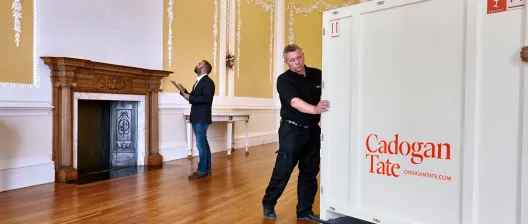Celebrating Herbert Vogel
Herbert Vogel, a former postal clerk, who along with his librarian wife Dorothy came to symbolise something beautiful and pure about the pursuit of art, has died at the age of 89.
For over five amazing decades, this patently unpretentious couple came to own one of the most interesting, varied and critically laudable private art collections in the world. They didn’t come from money, didn’t have connections, weren’t rich by any standard definition of wealth, yet, through Herbert’s instinctive eye for good art, did achieve the impossible.
And it was all accomplished from a small, indistinct New York apartment, on salaries that were typically average, if that. Dorothy initially wasn’t as enthusiastic about art as Herbert was; this came later, after they married in 1962, infectious as his enthusiasm was.
They decided that the income she brought in at the Brooklyn Public Library would be a living wage for both of them, while his earnings as a clerk would be invested into artworks. It would mean a prudent life, but one nevertheless enriched by the beauty of the paintings hanging around their home.
Their tastes were unequivocally modern and they particularly enthused about contemporary, minimal and conceptual art. In total, they gathered around 5,000 works of art, many of which were later gifted to various museums. The bulk of the works went to the National Museum of Art, Washington – a smart move to ensure a legacy of sorts would be realised.
As Herbert told the Houston Chronicle 20 years ago, the gift was their way of giving something back to the nation, a captivating collection to enjoy forever more. The gallery, he said, doesn’t sell work that it comes into possession of, and thus, collections are preserved. And they don’t charge for entry, he quipped.
“The radical expansion of intellectual and stylistic expressions in many media by European and American artists since the 1960s is reflected in the diversity of the works that Herb and Dorothy collected over five decades,” observed Earl A Powell III, director of the National Gallery of Art.
“We will miss Herb’s astute eye and wry sense of humour and we give our heartfelt condolences to Dorothy. We are forever grateful for their generosity in pledging so much of their collection to the nation.”
Such heartfelt words come from a consensus of opinion, especially among critics, that Herbert was a visionary man, a quality he derived from his early foray into art. Born in New York in 1922, Herbert, from Russian Jewish ancestry, first served stateside in the US army during the Second World War, after which he began his long career in the postal service.
In his spare time, he displayed an autodidactic approach to art, educating himself with endless visits to museums, complementing the experiential learning with art classes at the Institute of Fine Arts. He also dabbled in painting himself, learning techniques and styles at New York University.
Herbert was fast becoming a man who simply loved art, which was further reflected and realised during the many hours he spent at the Cedar Bar, a favourite haunt for artists and cultured folk. Good company like that set Herbert onto a road of discovery.
Though he started buying works of art prior to meeting Dorothy, it was only through the financial liberation of a joint income that the Vogels could really start their building of an inspiring collection. This included works like Richard Anuszkiewicz’s Temple of Red with Orange, Ann Chernow’s I Get Along Without You Very Well, Don Hazlitt’s Peanuts #3 and Hap Tivey’s Sentinel, to name but a few.
A famous anecdote that is ascribed to the couple is their basic requirements for a work of art: it had to be portable enough to ride home with them on the subway or in a taxi; had to be affordable; and it had to fit into their small apartment.
But there is more than just practicality that influenced their decisions, a canny balance between cerebral and emotional impulses. You could argue that they simply had good taste. They might have existed on the periphery of the establishment, but what people wouldn’t have given for even a sliver of their collection.
The ironic thing is they never intended to be collectors per se; they simply wanted to live with art, experience it, to deepen and enhance their lives. This was the beautiful life, not material riches or social status: just art, and very sweetly, one another – pure love. They redefined what it meant to be a collector.
“The work might have been right, but the people weren’t ready for that kind of work,” Mr Vogel said in 1994. “So it was revolutionary for many, many people, which very often happens when something does break convention or tradition. Later on, if it is very, very good, it will be picked up by history.”
Herbert Vogel passed away peacefully at Kateri Residence, a skilled nursing and rehabilitation centre in New York. He is survived by Dorothy, his wife of 50 years; his sister Paula Entebi; two nephews, one niece and three great-nephews; and his much-treasured cat Archie.



